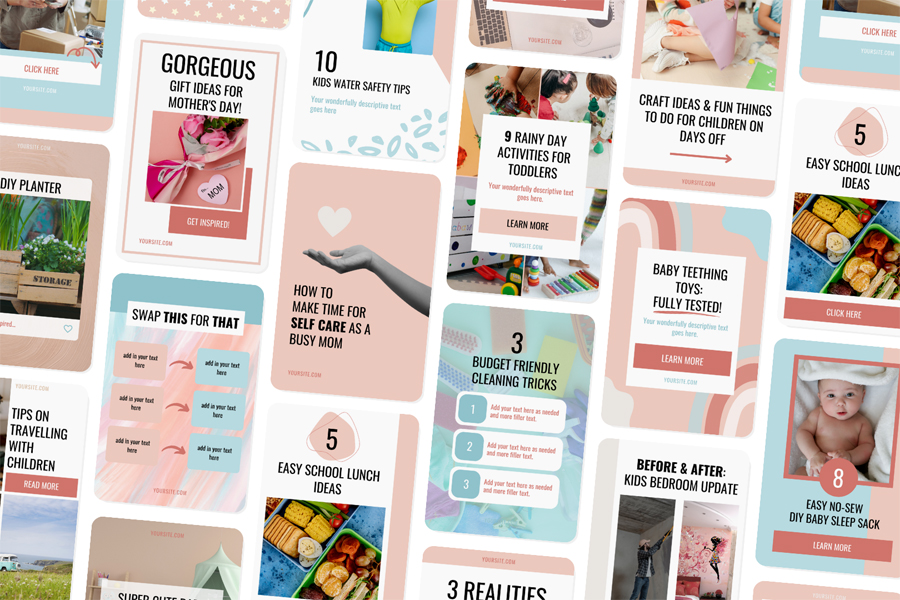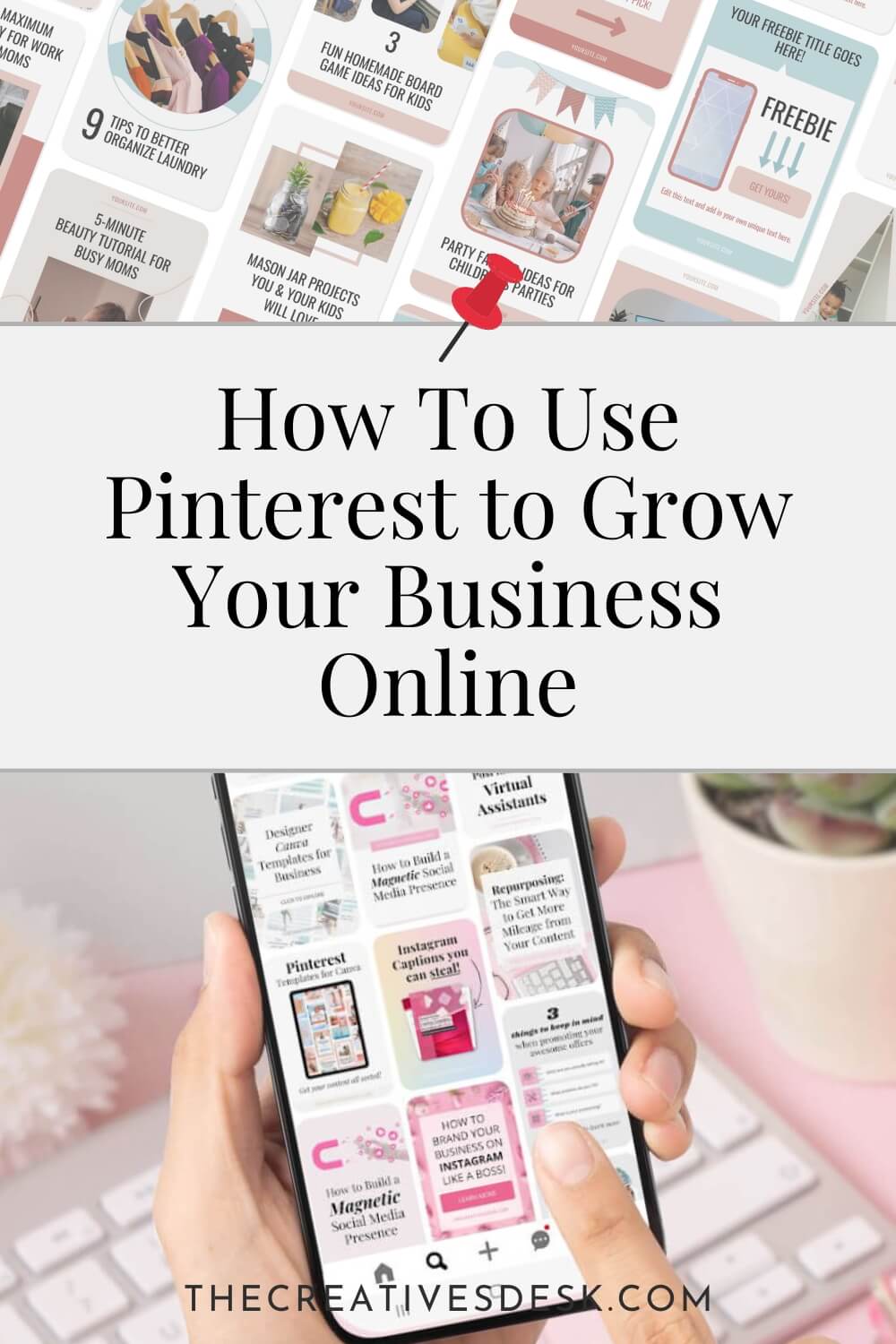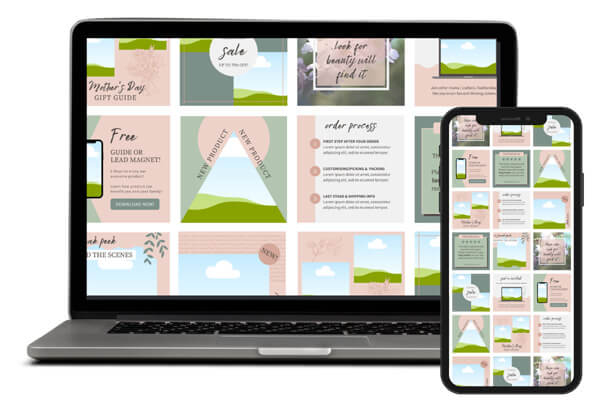

Last updated: February 2025
As an online business owner with a creative digital marketing background, I have utilized Pinterest for marketing for over 10 years.
Pinterest has changed a lot for businesses and bloggers in that time, so in this article, I’m sharing the best up-to-date practices and pinning strategies I’ve learned, and that I’m using right now.
See the date above for when this article was last updated!
Let’s start with having a look at what Pinterest is and how you can use it to grow your small business online.
Pinterest isn’t a social network, it’s really a search engine but laid out in a much more visual way than other search engines.
Most people use it to gather ideas for things like recipes, gift ideas, living room design, weddings, seasonal décor, outfits, and so much more!
The possibilities are endless; whatever you’re searching for, you’re bound to find some ideas or content about it on Pinterest.
Pinterest can be used as a powerful traffic generation and lead sourcing tool for a variety of small businesses and brands. Many business owners and bloggers have reported that 50-90% of their organic referral traffic comes from Pinterest!
The majority of Pinterest users are women which is great news if your target market includes women, since women influence 70-80% of consumer spending.
In 2023, 76.2% of Pinterest audiences are female and the number of male users is 17.2% and steadily growing. This trend looks set to continue through 2025. You can find up-to-date Pinterest user stats here.
In no particular order, here’s a list of some of the most popular categories on Pinterest.
So if any of your products, services or blog content fall under one or more of these categories, then you know there’s an audience on Pinterest waiting to find you! It’s all about making the most of the huge number of people using the internet, and marketing your products in the places where these people are already showing up.
One up and coming category not always mentioned on lists provided by Pinterest is the business category. If you offer B2B services, there are growing opportunities to gain traffic from Pinterest – especially if you have a blog providing helpful info and resources.
Before you pin anything, it is SO important that you conduct keyword research to ensure your efforts are not wasted. The keywords you find should be used in the titles and descriptions of both your pins and boards.
To find suitable keywords, search on Pinterest itself – don’t use Google search term keywords (for example) as many won’t be relevant. Use keywords from the Pinterest search bar suggested keywords and from the pin descriptions and board descriptions of other accounts in your niche – but don’t copy descriptions word for word.
Create a list of suitable keywords relevant to your content and business. From your new list, only use your keywords when relevant for the content; Pinterest algorithms can detect keyword stuffing and this may decrease your reach!
Hashtags were removed by Pinterest but in 2024 they made a return I currently don’t bother to use them, but if you would like to include them, I recommend researching the best to use and have a max of 3-4 per pin description.

I see lots of experts recommend that people pin 10-30 pins a day. However, for so many people this is not feasible.
Lots of people, including myself are getting good results from just sharing 4 pins every day.
You can learn about my 30-minute weekly pinning routine that I follow each week as well as find out how I stay organized with my pins.
When it comes to pins, Pinterest says it prefers fresh images in the 2:3 pin format. Avoid spending time on square or landscape images; vertical formats do much better on Pinterest.
I also want to note that I’ve been getting good results from pinning the longer pins (1080 x 1920px) which is a 9:16 ratio.
When pinning on Pinterest, prioritize sharing your own content rather than repinning content from other accounts.
To maximize your reach and engagement, try to avoid sharing the same URL more than once a day.
Consistency is key in building your Pinterest presence, so stick to a regular posting schedule to keep your audience engaged and interested.
Every 2-3 months review your boards and consider archiving those that no longer align with your business goals.
Additionally, if there are boards you haven’t pinned anything to in a while, it might be time to consider archiving to keep your profile fresh and focused.
Of course, an essential part of your strategy is creating attractive pins to catch the eye of people and encourage them to view your pins, save and click through to the landing page.
Check out my post featuring several Pinterest pin design ideas and tips.

Batch creating large collections of pins for each page or post can save you heaps of time.
For each URL (post or page I want to share) I create a set of unique pins where all I need to do is tweak the design a little (design elements, colors etc) to ensure Pinterest sees the design as a fresh new pin!
To get a head start on the task of creating fresh pins, you can purchase Pinterest template kits here – designed with several types of content in mind including one of our most popular Pinterest Canva templates.
You can schedule a batch of pins using the Pinterest scheduler or an approved scheduler like Tailwind or Buffer.
In early 2024, I started using Buffer and I have to say I think it’s the quickest pin uploading workflow out of all the options.
However, that said I have gone back to using the scheduler on Pinterest.
However, if you don’t get on with either of those – Tailwind is still a viable option…
The first reason is its super useful analytics, plus they email these to you weekly if you’d like a snapshot of your account stats every week.
The second great thing in Tailwind is called Tailwind Communities; these are essentially pin sharing niched groups.
With Communities you’re much more likely to get others pinning/sharing your pins as for them to work, every contributor has to repin from that community. This means your content will be seen by even more relevant audience members.
It’s a win-win situation because you get great content to repin (which helps your Pinterest algorithm), and your pins will receive shares too. Pinning others pins is the social sharing aspect of Pinterest.
If you were wondering how long you can expect to see growth, new Pinterest accounts can see results in 4-6 weeks.
On established accounts, when major changes are made to pins and boards, stats tend to go down the first 2-3 weeks then slowly pick up and build momentum once SEO kicks in.
This makes it a great way to build and continue to grow an online audience who are specifically *looking* for the content – and products or services – that you’re offering.
The key to success is to keep pinning and stay consistent with it. The importance of this is mentioned in this Pinterest case study about creating fresh pins.
📌 Most of what you pin should be your content and NOT other people’s.
📌 Share a mixture of both 2:3 pins and the taller (story sized) pins.
📌 Don’t waste time posting square or landscape images.
📌 Try not to share the same URL more than once per 24 hours.
📌 Consistency is your friend, keep to a regular posting schedule.
📌 Research (don’t guess) the keywords people are using to search Pinterest. Use these keywords in your pin titles, descriptions, and on your relevant boards.
📌 Archive boards that no longer align with your business, as well as boards you haven’t pinned to in a while.
It’s worth remembering that posting organically on Pinterest is a long-term strategy – definitely worth doing in my opinion – even if it seems a little on the slow side to get going.
So in the meantime, I invite you to have a look around my Pinterest account.
Don’t miss this free resource download 👇
Free Social Media Captions & Ideas for Product-Based Businesses

Share to…

Sign up to get 10 free Canva templates for your social media.
Created with solopreneurs in mind, these templates offer a variety of content types to help boost your online presence!